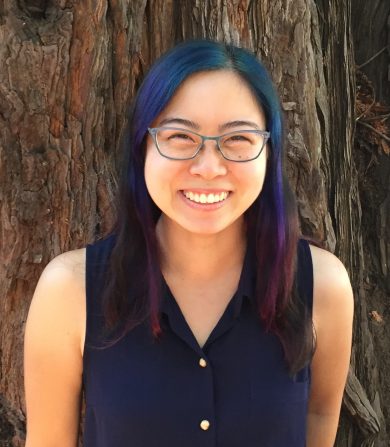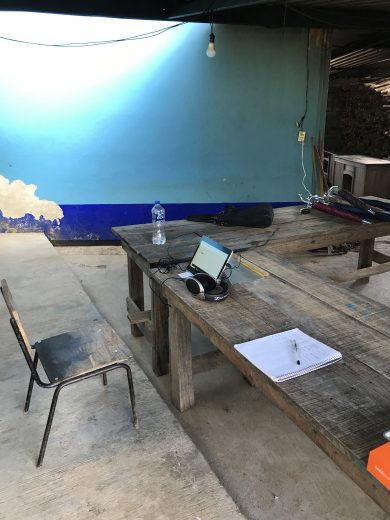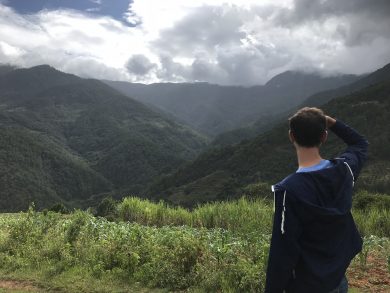Graduate Profile: Kelsey Sasaki, Linguistics Doctoral Student

Kelsey Sasaki is a PhD Candidate in the Linguistics Department at UC Santa Cruz. Sasaki is currently working on her dissertation and serving as a THI Year-Long Public Fellow.
In November, we spoke with Sasaki about her research and experience as a THI Public Fellow. In this capacity, Sasaki is working with Senderos on administrative support for the group and language materials management for the programming they provide. In our conversation, we discussed the ways in which Sasaki’s own work and research has interfaced with her role in supporting the sharing and celebration of the indigenous languages of Oaxaca with the greater Santa Cruz community.
Thanks for taking the time to speak with us Kelsey! To help ground our conversation, would you mind just telling us in broad strokes about your work?
Thank you! Broadly, my work explores how we construct and interpret multi-sentence narratives. That is, I’m interested in how we track the myriad strands of information in a narrative, such as the character(s) and the within-narrative timeline, and weave all of those strands into a complete internal representation. (My work is in the same general vein as that of recent UCSC Linguistics alum Margaret Kroll.)
I’m interested in how we track the myriad strands of information in a narrative, such as the character(s) and the within-narrative timeline, and weave all of those strands into a complete internal representation.
In my dissertation, I’m working to unite two bodies of discourse research that historically have barely acknowledged each other. The first, coherence theory, is rooted in linguistics and computer science. Coherence theorists argue that there is a small set of possible relations between two clauses in a discourse. With just this limited set of relations, one can build representations of quite complex, lengthy discourses. The second body of research, situation model theory, is rooted in psychology. It proposes that we construct mental representations of discourses by tracking certain “dimensions,” such as spatial and temporal locations. These two frameworks have a lot to offer one another, but bridging the gap between them will be no small feat. My dissertation is just one step in the bridging process, but one that I hope will deepen our understanding of how we construct and experience narratives.
Your research interests lie in “pragmatics, semantics, psycholinguistics, and syntax.” For those of us outside the field of linguistics, can you walk us through the basics of these different interests? What do they help us know about the study of language?
Syntax is the study of the internal structure of sentences. This includes, for example, the rules about how words get combined into phrases in a given language. Let’s say we want to modify a noun with an adjective in English. We’d follow a syntactic rule that puts the adjective before the noun, as in “sweet mango.” In Spanish, we’d follow a rule that puts the adjective after the noun, as in “mango dulce”.

Semantics is the study of linguistic meaning. This includes the meanings of individual words and the meanings of phrases composed of multiple words. “Meaning” encompasses our mental representations of what a word or phrase means and the things in the real world that a word or phrase picks out.
As for pragmatics, I’m cheating a bit here, but I’m going to quote Margaret Kroll’s THI profile because I really couldn’t put it any better: Pragmatics is “the interdisciplinary attempt to understand how we understand what a given utterance or text means based not only on the literal meaning of what is said, but also on accounts of human behavior that include a speaker’s intentions and goals.”
Psycholinguistics is the study of the psychological mechanisms by which we comprehend, produce, and build mental representations of linguistic information in real-time.
Part of your work focuses on Santiago Laxopa Zapotec, a language primarily spoken in Oaxaca. How has studying this particular language interfaced with your broader research interests?
I’ve been very fortunate to be part of a team project on Santiago Laxopa Zapotec. We’re investigating certain syntactic properties of the language from a psycholinguistic perspective. (This project fits into the larger, cross-linguistic project for which three of my professors were recently awarded an NSF grant!) In a broader sense, I’m very grateful for the opportunity to do community-centered fieldwork with Santiago Laxopa Zapotec speakers. There is a good deal of interest in educational materials development for the language, both in the Santa Cruz area and in the town of Santiago Laxopa. Working to create resources that help Laxopeños preserve and share their language is actually one of my favorite parts of being a linguist.
That is absolutely fascinating and sounds like really important work. And in addition, you’re also an organizer of Nido de Lenguas. What would you like readers to know about this project?
Working to create resources that help Laxopeños preserve and share their language is actually one of my favorite parts of being a linguist.
Nido de Lenguas is a partnership between UCSC Linguistics and Senderos, a nonprofit that serves the Latino/Latinx community in and around Santa Cruz. Our goal is to share and celebrate the indigenous languages of Oaxaca with the greater Santa Cruz community. To do this, a small group of UCSC linguists (myself included) works with native speakers of Oaxacan languages to create language-learning materials such as games, group exercises, and worksheets. We are mainly focused on two languages right now: Santiago Laxopa Zapotec and San Martín Peras Mixtec. We hold twice-monthly classes in Santiago Laxopa Zapotec, led by native speaker Maestra Fe Silva-Robles, Senderos’ co-founder. Before the pandemic, we also hosted pop-up tables at Senderos events and put on weekend workshops. This year, we’re working to adapt some of our activities to be played online, or downloaded and printed. I encourage interested readers to check out our website, sign up for our mailing list, or email us with any questions about Oaxacan languages or our work at Nido de Lenguas!
This year you’ve been working as a 2020-2021 THI Public Fellow with Senderos. What has your experience been like in this capacity so far? What are you looking forward to for the rest of the year as a public fellow?

I’m really enjoying my work as a Public Fellow! I’m deeply grateful to both THI and Senderos for this opportunity. My responsibilities fall into two basic categories—administrative support for Senderos, and language materials management for Nido de Lenguas. Those are both fairly wide umbrellas, though! Just a few of my tasks so far have included grant research, purchasing musical instruments (exciting for this former band geek!), and creating online versions of the Nido de Lenguas games. I also get to attend Senderos’ leadership meetings, in which I learn so much from Fe and Nereida Robles—the sisters who founded Senderos—Carolyn and Curt Coleman, and Helen Aldana. Their deep commitment to serving the Senderos community, as well as their vast knowledge of nonprofit work, K-12 education, and cultural education, is truly inspiring and humbling. Senderos is entirely volunteer-run, and their work is so vital, especially during the pandemic.
On top of adapting their free academic tutoring and folkloric dance and music classes for Zoom, they are working with the Community Foundation to distribute monthly COVID aid to almost 200 families, and providing computer literacy classes to dozens of parents and students. I’m honored to be even a small part of all this work. On the Senderos side of my work, I’m looking forward to interacting with the Senderos families more next quarter. On the Nido de Lenguas side, I’ll be working with a Oaxacan artist, Roque Reyes, to create alphabet charts and flashcards. He’s created lovely, humorous illustrations for us in the past, and I can hardly wait to see more of his work. Finally, we’ll soon be hiring two undergraduate Public Fellows! All this work goes better with a team, so I’m excited to bring more people on board.
